-
 Bitcoin
Bitcoin $116400
-0.36% -
 Ethereum
Ethereum $4033
3.40% -
 XRP
XRP $3.302
-1.26% -
 Tether USDt
Tether USDt $1.000
-0.02% -
 BNB
BNB $796.1
1.67% -
 Solana
Solana $177.8
1.89% -
 USDC
USDC $0.9999
0.00% -
 Dogecoin
Dogecoin $0.2314
4.09% -
 TRON
TRON $0.3381
0.14% -
 Cardano
Cardano $0.7989
1.22% -
 Stellar
Stellar $0.4496
-1.84% -
 Chainlink
Chainlink $20.42
9.42% -
 Hyperliquid
Hyperliquid $41.17
0.88% -
 Sui
Sui $3.914
3.77% -
 Bitcoin Cash
Bitcoin Cash $584.7
1.52% -
 Hedera
Hedera $0.2632
-0.54% -
 Avalanche
Avalanche $24.09
3.40% -
 Ethena USDe
Ethena USDe $1.001
-0.02% -
 Litecoin
Litecoin $123.2
1.33% -
 Toncoin
Toncoin $3.318
-0.04% -
 UNUS SED LEO
UNUS SED LEO $8.984
-0.05% -
 Shiba Inu
Shiba Inu $0.00001323
2.85% -
 Uniswap
Uniswap $10.90
4.41% -
 Polkadot
Polkadot $3.999
3.34% -
 Dai
Dai $1.000
0.01% -
 Cronos
Cronos $0.1630
9.64% -
 Bitget Token
Bitget Token $4.484
0.82% -
 Monero
Monero $272.4
2.44% -
 Pepe
Pepe $0.00001173
6.03% -
 Aave
Aave $290.8
2.88%
What does it mean that the volume suddenly increases by 3 times but the increase is limited?
A sudden threefold increase in trading volume with minimal price movement often signals market manipulation, institutional activity, or temporary hype without strong fundamental support.
Jun 20, 2025 at 10:07 pm
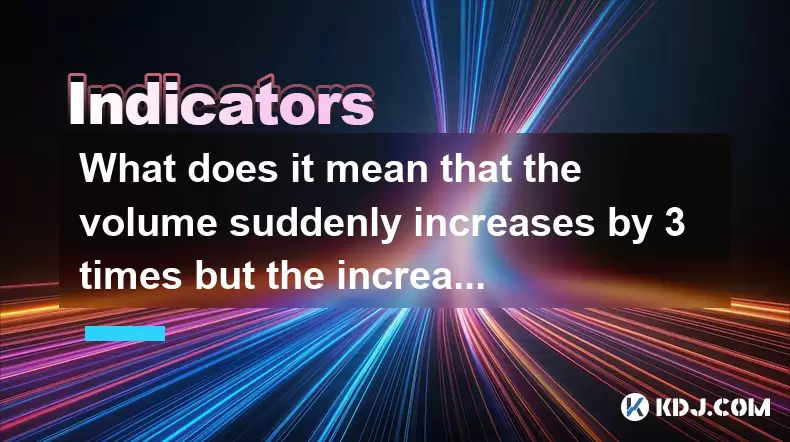
Understanding Sudden Volume Surges in Cryptocurrency Trading
In the world of cryptocurrency trading, sudden changes in volume are common, but when a digital asset sees its trading volume jump by three times within a short period, it raises questions. This phenomenon typically indicates increased market interest or activity surrounding the asset. However, when this surge is followed by a limited price increase, it can confuse traders and investors alike.
A sudden volume spike often points to market manipulation, large trades from institutional players, or significant news events impacting investor sentiment. The key here is to distinguish between real demand and temporary noise. High volume without a corresponding upward movement in price suggests that while many people are buying and selling, the market isn’t convinced about long-term value appreciation.
Why Would Volume Increase Without Price Movement?
When volume increases dramatically but the price remains stagnant or rises only slightly, it may indicate a tug-of-war between buyers and sellers. In such scenarios, large orders might be placed and canceled repeatedly—a tactic known as spoofing—to create an illusion of market depth and activity.
Another explanation could involve profit-taking or resistance testing. If a cryptocurrency has been trading around a specific resistance level, increased volume may signal attempts by bulls to push the price higher. However, if bears step in at that level and start selling aggressively, the price fails to break through, resulting in high volume with minimal price gain.
Additionally, during periods of high volatility, stop-loss orders can trigger mass liquidations. These events can cause temporary spikes in volume without necessarily altering the overall trend.
How Institutional Activity Affects Volume and Price Dynamics
Institutional investors often trade in large volumes, which can significantly affect the perceived liquidity and momentum of a cryptocurrency. When these entities accumulate or distribute assets, they do so gradually to avoid slippage. This leads to higher-than-usual trading volumes over time.
However, because their trades are executed slowly, the price doesn't move drastically. Retail traders might interpret the rising volume as a sign of strength, but in reality, the institutional activity is neutralizing potential price swings. As a result, even though volume triples, the price barely budges.
This kind of behavior is especially noticeable in less liquid altcoins, where a single whale-sized transaction can dominate the order book and skew volume metrics.
The Role of Market Sentiment and News Events
Cryptocurrency markets are highly sensitive to news, rumors, and social media trends. A viral tweet or a major regulatory update can send trading volume soaring. However, if the news turns out to be inconclusive or negative in the long run, the initial excitement fades, and the price stabilizes.
For example, if a project announces a partnership that initially excites the community, volume might rise sharply. But upon closer inspection, if the partnership lacks substance or implementation details, traders may sell off their holdings quickly, leading to high volume but little to no sustained price movement.
Moreover, short-term pump-and-dump schemes also exhibit similar patterns. Organizers artificially inflate volume through coordinated buys, then dump their positions once retail traders follow suit. The outcome is a sharp volume spike followed by a rapid price drop or stagnation.
Technical Indicators That Help Interpret Volume Spikes
To better understand what's happening behind the scenes, traders rely on technical analysis tools that incorporate volume data. One such tool is the On-Balance Volume (OBV) indicator, which adds volume on up days and subtracts it on down days. A rising OBV despite flat prices might suggest accumulation, while a falling OBV could indicate distribution.
The Volume Weighted Average Price (VWAP) also plays a crucial role in interpreting volume surges. If the price stays close to VWAP during a volume spike, it suggests that the market is still balanced and no clear direction has emerged yet.
Another useful metric is the Chaikin Money Flow (CMF), which measures buying and selling pressure over a set period. A CMF near zero during high volume implies that neither bulls nor bears are gaining control, supporting the idea of limited price movement despite increased activity.
How to Respond Strategically to Such Market Conditions
Traders should approach situations where volume jumps but price stagnates with caution. Here are some actionable steps:
- Analyze Order Book Depth: Look for signs of spoofing or wash trading by checking for large orders that appear and disappear quickly.
- Review Recent News: Determine whether the volume spike was triggered by genuine developments or hype.
- Monitor On-Chain Metrics: Tools like blockchain explorers can reveal large wallet movements that may explain sudden volume increases.
- Use Volume-Based Indicators: Incorporate OBV, VWAP, and CMF into your analysis to gauge underlying momentum.
- Avoid FOMO Trading: Don’t enter positions solely based on volume spikes without confirming price action or fundamentals.
By combining technical tools with fundamental insights, traders can make more informed decisions rather than reacting impulsively to misleading signals.
Frequently Asked Questions
Q: Can high volume with limited price movement indicate a breakout is coming?
Yes, sometimes high volume without a strong price move suggests that a breakout is imminent, especially if the asset is trading near a key support or resistance level. However, confirmation via candlestick patterns or volume continuation is necessary before assuming a breakout will occur.
Q: Is it safe to buy during a volume surge if the price hasn’t risen much?
Not necessarily. Buying during a volume surge without clear price confirmation can be risky due to possible manipulation or profit-taking. It’s advisable to wait for a breakout above resistance or a bullish candlestick pattern before entering a position.
Q: How can I differentiate between organic volume growth and artificial volume?
Artificial volume often shows spikes without corresponding price moves, frequent large order cancellations, or repetitive trading patterns. Checking on-chain data and exchange order books can help identify whether the volume is genuine or manipulated.
Q: What timeframes are most affected by volume anomalies?
Shorter timeframes like 1-minute or 5-minute charts are more prone to false volume spikes due to high-frequency trading and bots. Longer timeframes such as 4-hour or daily charts provide a clearer picture of authentic volume trends and should be prioritized for serious analysis.
Disclaimer:info@kdj.com
The information provided is not trading advice. kdj.com does not assume any responsibility for any investments made based on the information provided in this article. Cryptocurrencies are highly volatile and it is highly recommended that you invest with caution after thorough research!
If you believe that the content used on this website infringes your copyright, please contact us immediately (info@kdj.com) and we will delete it promptly.
- SHIB Price, Meme Coin Mania, and the 250x Potential Hunt
- 2025-08-09 16:30:13
- SOL, ETFs, and AI: Crypto's Triple Threat Sensation!
- 2025-08-09 17:10:12
- Tokenized Stock on Solana: SOL Price Reacts to Exodus's Bold Move
- 2025-08-09 17:10:12
- Cardano, Mutuum Finance, Millionaires 2025: A New Wave of Crypto Fortunes?
- 2025-08-09 17:50:12
- Meme Coins on Blockchains in 2025: Hype or the Future?
- 2025-08-09 16:50:11
- World Liberty Financial, Public Listing, and WLFI Tokens: A New York Minute on the Trump-Backed Crypto Venture
- 2025-08-09 16:50:11
Related knowledge

What does it mean when the Triple Moving Average (TRIX) turns downward but the price doesn't fall?
Aug 09,2025 at 12:42pm
Understanding the Triple Moving Average (TRIX) IndicatorThe Triple Moving Average, commonly known as TRIX, is a momentum oscillator designed to filter...

What does it mean when the Williams' oscillator repeatedly hits bottoms but fails to rebound?
Aug 09,2025 at 09:28am
Understanding the Williams %R OscillatorThe Williams %R oscillator, developed by Larry Williams, is a momentum indicator used in technical analysis to...
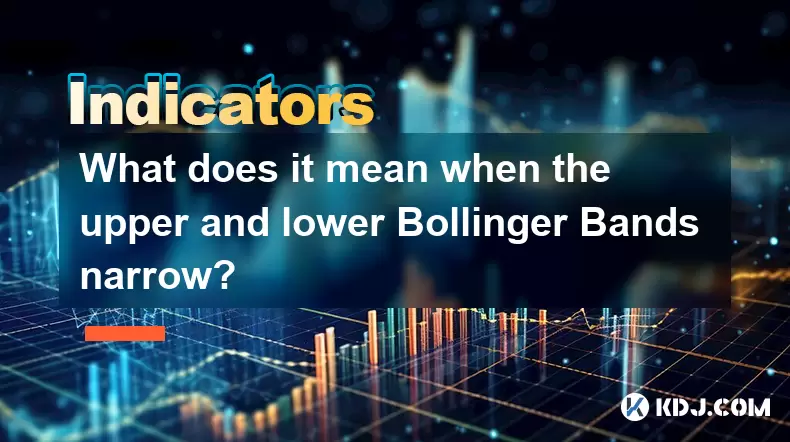
What does it mean when the upper and lower Bollinger Bands narrow?
Aug 09,2025 at 03:00pm
Understanding Bollinger Bands in Cryptocurrency TradingBollinger Bands are a widely used technical analysis tool in the cryptocurrency market, develop...
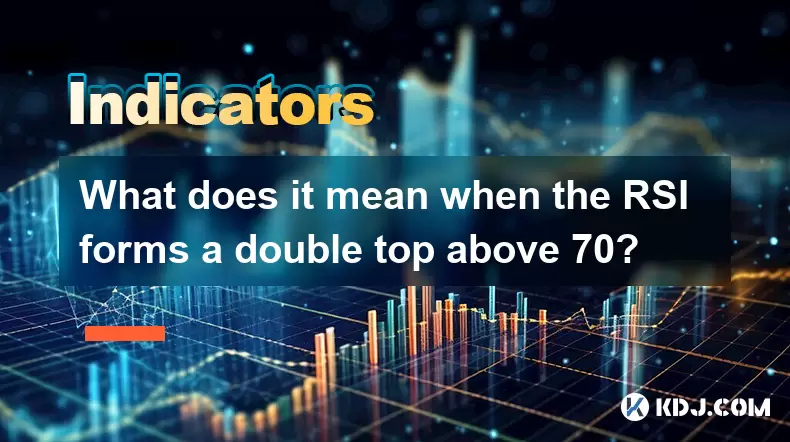
What does it mean when the RSI forms a double top above 70?
Aug 09,2025 at 05:50pm
Understanding the RSI and Overbought ConditionsThe Relative Strength Index (RSI) is a momentum oscillator that measures the speed and change of price ...
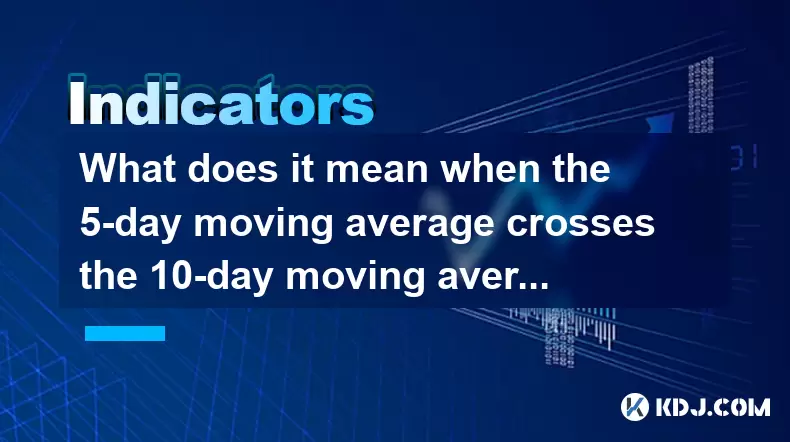
What does it mean when the 5-day moving average crosses the 10-day moving average but the 20-day moving average remains upward?
Aug 09,2025 at 03:35pm
Understanding Moving Averages in Cryptocurrency TradingMoving averages are foundational tools in technical analysis, especially within the cryptocurre...
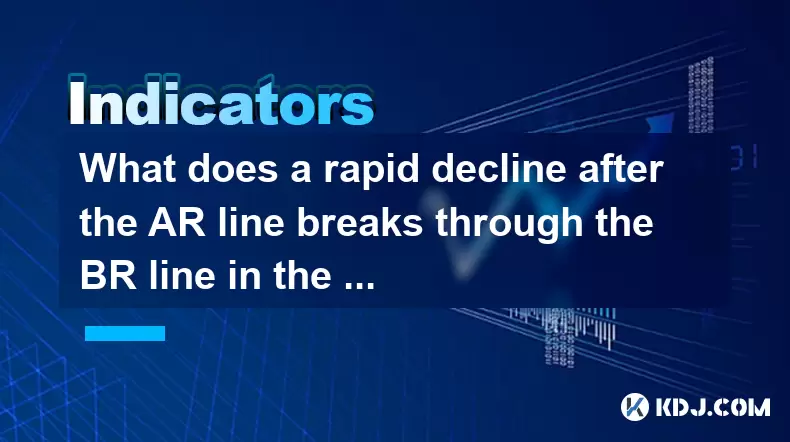
What does a rapid decline after the AR line breaks through the BR line in the ARBR indicator indicate?
Aug 09,2025 at 04:42pm
Understanding the ARBR Indicator ComponentsThe ARBR indicator is a technical analysis tool that combines two oscillators: the AR (Amplitude Ratio) and...

What does it mean when the Triple Moving Average (TRIX) turns downward but the price doesn't fall?
Aug 09,2025 at 12:42pm
Understanding the Triple Moving Average (TRIX) IndicatorThe Triple Moving Average, commonly known as TRIX, is a momentum oscillator designed to filter...

What does it mean when the Williams' oscillator repeatedly hits bottoms but fails to rebound?
Aug 09,2025 at 09:28am
Understanding the Williams %R OscillatorThe Williams %R oscillator, developed by Larry Williams, is a momentum indicator used in technical analysis to...

What does it mean when the upper and lower Bollinger Bands narrow?
Aug 09,2025 at 03:00pm
Understanding Bollinger Bands in Cryptocurrency TradingBollinger Bands are a widely used technical analysis tool in the cryptocurrency market, develop...

What does it mean when the RSI forms a double top above 70?
Aug 09,2025 at 05:50pm
Understanding the RSI and Overbought ConditionsThe Relative Strength Index (RSI) is a momentum oscillator that measures the speed and change of price ...

What does it mean when the 5-day moving average crosses the 10-day moving average but the 20-day moving average remains upward?
Aug 09,2025 at 03:35pm
Understanding Moving Averages in Cryptocurrency TradingMoving averages are foundational tools in technical analysis, especially within the cryptocurre...

What does a rapid decline after the AR line breaks through the BR line in the ARBR indicator indicate?
Aug 09,2025 at 04:42pm
Understanding the ARBR Indicator ComponentsThe ARBR indicator is a technical analysis tool that combines two oscillators: the AR (Amplitude Ratio) and...
See all articles

























































































